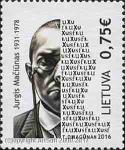George Maciunas
George Maciunas
Place: Kaunas
Born: 1931
Death: 1978
Biography:
George Maciunas was a Lithuanian American artist. He was a founding member and the central coordinator of Fluxus, an international community of artists, architects, composers, and designers. Other leading members brought together by this movement included Ay-O, Joseph Beuys, Jonas Mekas, George Brecht, Dick Higgins, Yoko Ono, Nam June Paik and Wolf Vostell.
He is most famous for organising and performing early happenings and for assembling a series of highly influential artists' multiples.
His father, Alexander M. Maciunas, was a Lithuanian architect and engineer who had trained in Berlin, and his mother, Leokadija, was a Russian-born dancer from Tiflis affiliated with the Lithuanian National Opera and, later, Aleksandr Kerensky's private secretary, helping him complete his memoirs.
After fleeing Lithuania to avoid being arrested by the advancing Red Army in 1944, and living briefly in Bad Nauheim, Frankfurt, Germany, Jurgis Mačiūnas and his family emigrated to the USA in 1948, living in a middle class area of Long Island, New York.
After arriving in the USA, George studied art, graphic design, and architecture at Cooper Union, architecture and musicology at the Carnegie Institute of Technology in Pittsburgh and finally art history at New York University's Institute of Fine Arts specializing in the European and Siberian art of migrations. His studies lasted eleven years from 1949 to 1960 and were completed in succession. This began a fascination with the history of art for the rest of his life, and whilst there he began his first art-history chart, measuring 6 by 12 foot, a "time/space chart categorizing all past styles, movements, schools, artists etc." between 1955 and 1960. Whilst this project remained unfinished, he would publish three versions of a history of the avant-garde. The first appeared in 1966, with Fluxus as the focal point. He also began a correspondence with Raoul Hausmann, an original member of Berlin Dada, who advised him to stop using the term "neo-dada" and concentrate instead on "fluxus" to describe the nascent movement.
Duke University Professor Kristine Stiles has discussed Fluxus as part of a movement towards global humanism achieved through the breakdown of boundaries in artistic media, cultural norms, and political conventions. The blurring of cultural conventions, which began in the early 20th century with movements such as Dada and Futurism, was continued by Fluxus artists in correspondence with the changes taking place in the sixties. Like the definition of "Flux", which means "to flow", Fluxus artists sought to reorder the temples of production and reveal "the extraordinary that remains latent in the undisclosed ordinary" during the midst of the dramatic modernist epoch.
Primarily influenced by John Cage's Experimental Music Composition classes at the New School for Social Research and an emerging interest in eastern philosophy, a number of avant-garde artists in New York were beginning to run parallel and competing happenings at the beginning of the 1960s.
As well as Maciunas' concerts at the AG Gallery in March 1961 featuring music and events by Maciunas himself, Toshi Ichiyanagi, Mac Low and Dick Higgins, the two other most important precursors to fluxus were La Monte Young's influential series of performances in the Chambers Street loft of Yoko Ono and Toshi Ichiyanagi in 1961 involving Henry Flynt, La Monte Young, Joseph Byrd & Robert Morris amongst others; and Robert Watts and George Brecht's Yam Festival, spring 1963 at Rutgers University and New York, which included a series of mail art event scores and performances by John Cage, Allan Kaprow, Alison Knowles, Ay-O and Dick Higgins. All of these artists and more eventually became associated with fluxus, 'either through their collaboration on multiples, inclusion in anthologies, or participation in Fluxus concerts'.
Other key influences noted by Maciunas included the happenings that had occurred at the Black Mountain College involving Robert Rauschenberg, John Cage, David Tudor, Merce Cunningham and others; the Nouveaux Réalistes; the Concept Art of Henry Flynt and Marcel Duchamp's notion of the readymade.
Though Maciunas conceived of the name "Fluxus" for a publication covering Lithuanian Culture conceived of during a meeting of Lithuanian émigrés, Fluxus soon developed into much more. Fluxus became an avant-garde movement characterized by playful subversion of previous art traditions (even including those of previous avant-garde movements), Dick Higgins' famously coined term intermedia, a view that art should not-be something rarefied or commercial, and a firm commitment to blurring the distinctions between art and life. Maciunas' lifelong interest in diagrams made him chart the political, cultural and social history as well as art history and the chronology of Fluxus.
In 1963, Maciunas composed the first Fluxus Manifesto, (see above), which called upon its readers to:
More...
Wikipedia link: Click Here














